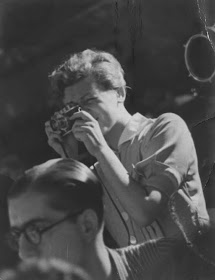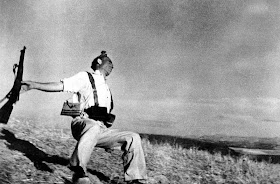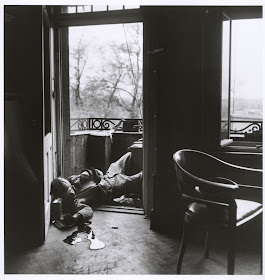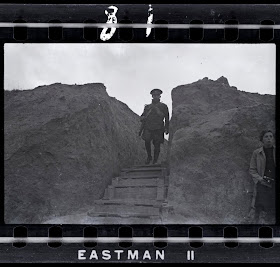Robert Capa was an American born in Budapest ,1913 (he died in Indochina 1954)
On 3 December 1938 Picture Post introduced 'The Greatest War Photographer in the World: Robert Capa' with a spread of 26 photographs taken during the Spanish Civil War.
But the 'greatest war photographer' hated war. Born Andre Friedmann to Jewish parents in Budapest in 1913, he studied political science at the Deutsche Hochschule für Politik in Berlin. Driven out of the country by the threat of a Nazi regime, he settled in Paris in 1933.
He was represented by Alliance Photo and met the journalist and photographer Gerda Taro. Together, they invented the 'famous' American photographer Robert Capa and began to sell his prints under that name. He met Pablo Picasso and Ernest Hemingway, and formed friendships with fellow photographers David 'Chim' Seymour and Henri Cartier-Bresson.
From 1936 onwards, Capa's coverage of the Spanish Civil War appeared regularly. His picture of a Loyalist soldier who had just been fatally wounded earned him his international reputation and became a powerful symbol of war.
After his companion, Gerda Taro (an accomplished photographer in her own right), was killed in Spain, Capa travelled to China in 1938 and emigrated to New York a year later. As a correspondent in Europe, he photographed the Second World War, covering the landing of American troops on Omaha beach on D-Day, the liberation of Paris and the Battle of the Bulge.
In 1947 Capa founded Magnum Photos with Henri Cartier-Bresson, David Seymour, George Rodger and William Vandivert. On 25 May 1954 he was photographing for Life in Thai-Binh, Indochina, when he stepped on a landmine and was killed. The French army awarded him the Croix de Guerre with Palm post-humously. The Robert Capa Gold Medal Award was established in 1955 to reward exceptional professional merit.
[via Magnum Photo]
Robert Capa taking a smoke break
Gerda Taro became a war photographer, and the lover and professional partner of photographer Robert Capa. Taro is regarded often as the first female photojournalist to cover the front lines of a war and to die while doing so. During her coverage of the Republican army retreat at the Battle of Brunete in Spain, Taro hopped onto the footboard of a car that was carrying wounded soldiers when a Republican tank collided into its side. Taro suffered critical wounds and died the next day, July 26, 1937
"If your pictures aren't good enough, you're not close enough."
~ Robert Capa
Robert Capa's most famous image, Falling Republican Militiaman, Spain 1936
“The desire of any war photographer is to be put out of business.” Capa
“The truth is the best picture, the best propaganda.” Robert Capa
"I hope to stay unemployed as a war photographer till the end of my life." - Robert Capa at the end of WWII
Departure of Chiang Kai-shek's German military advisors. Hankow, 1938
American soldier killed by German snipers, Leipzig, Germany, April 18, 1945
"It's not always easy to stand aside and be unable to do anything except record the sufferings around one." ~ Robert Capa
A Transylvanian Jew who had spent nine years in Nazi concentration camps, arriving in Israel in 1949
American soldier with war orphans "adopted" by his unit. London. 1943.
Spanish Civil War, Barcelona 1936
Running for shelter during the air raids. Bilbao, Spain, 1937.
Republican officer and Gerda Taro, University City, Madrid, February 1937
Man carrying a wounded boy, Teruel, Spain, late December 1937
Capa's photograph of his lover Gerda Taro alongside soldier on the front lines, Spain.
Robert Capa's famous photos of the Spanish Civil War (1936-39) -- pictures whose negatives were believed lost for 70 years. This cache of historic film, known as the "Mexican Suitcase," was smuggled out of Europe early in World War II, then lay hidden and forgotten for decades. [vis LIFE]
Robert Capa befriended Hemingway (pictured, center, along with New York Times reporter Herbert Matthews, rear, and two Republican soldiers in Teruel in 1937) while the famous American writer was covering the Spanish Civil War for a U.S. newspaper syndicate. Hemingway would later turn his war experiences into the novel For Whom the Bell Tolls. [LIFE]
After the Nationalist victory in Spain in early 1939, half a million Loyalists fled to France, where they were interned in refugee camps like this one in Bram. Capa spent much of March photographing their plight. Seven months later, as World War II began, Capa himself would flee for America, fearing his leftist politics would make him a target once the Nazis conquered France. In October, he abandoned his Paris darkroom and left behind the Mexican Suitcase negatives, never to see them again.


Henri Matisse on his bed signing a poster 1950
Ingrid bergman and Alfred Hitchcock on the set of Notorious, 1946
Picasso and son 1951
On 3 December 1938 Picture Post introduced 'The Greatest War Photographer in the World: Robert Capa' with a spread of 26 photographs taken during the Spanish Civil War.
But the 'greatest war photographer' hated war. Born Andre Friedmann to Jewish parents in Budapest in 1913, he studied political science at the Deutsche Hochschule für Politik in Berlin. Driven out of the country by the threat of a Nazi regime, he settled in Paris in 1933.
He was represented by Alliance Photo and met the journalist and photographer Gerda Taro. Together, they invented the 'famous' American photographer Robert Capa and began to sell his prints under that name. He met Pablo Picasso and Ernest Hemingway, and formed friendships with fellow photographers David 'Chim' Seymour and Henri Cartier-Bresson.
From 1936 onwards, Capa's coverage of the Spanish Civil War appeared regularly. His picture of a Loyalist soldier who had just been fatally wounded earned him his international reputation and became a powerful symbol of war.
After his companion, Gerda Taro (an accomplished photographer in her own right), was killed in Spain, Capa travelled to China in 1938 and emigrated to New York a year later. As a correspondent in Europe, he photographed the Second World War, covering the landing of American troops on Omaha beach on D-Day, the liberation of Paris and the Battle of the Bulge.
In 1947 Capa founded Magnum Photos with Henri Cartier-Bresson, David Seymour, George Rodger and William Vandivert. On 25 May 1954 he was photographing for Life in Thai-Binh, Indochina, when he stepped on a landmine and was killed. The French army awarded him the Croix de Guerre with Palm post-humously. The Robert Capa Gold Medal Award was established in 1955 to reward exceptional professional merit.
[via Magnum Photo]
The ever so suave Robert Capa
Robert Capa (left) in Naples, 1943, with Contax II camera and co-founder of Magnum Photo, George Roger
Gerda Taro became a war photographer, and the lover and professional partner of photographer Robert Capa. Taro is regarded often as the first female photojournalist to cover the front lines of a war and to die while doing so. During her coverage of the Republican army retreat at the Battle of Brunete in Spain, Taro hopped onto the footboard of a car that was carrying wounded soldiers when a Republican tank collided into its side. Taro suffered critical wounds and died the next day, July 26, 1937
"If your pictures aren't good enough, you're not close enough."
~ Robert Capa
Robert Capa's most famous image, Falling Republican Militiaman, Spain 1936
“The desire of any war photographer is to be put out of business.” Capa
“The truth is the best picture, the best propaganda.” Robert Capa
"I hope to stay unemployed as a war photographer till the end of my life." - Robert Capa at the end of WWII
Departure of Chiang Kai-shek's German military advisors. Hankow, 1938
American soldier killed by German snipers, Leipzig, Germany, April 18, 1945
A Transylvanian Jew who had spent nine years in Nazi concentration camps, arriving in Israel in 1949
American soldier with war orphans "adopted" by his unit. London. 1943.
Vietnam, 1954
Spanish Civil War, Barcelona 1936
Running for shelter during the air raids. Bilbao, Spain, 1937.
Republican officer and Gerda Taro, University City, Madrid, February 1937
Man carrying a wounded boy, Teruel, Spain, late December 1937
Capa's photograph of his lover Gerda Taro alongside soldier on the front lines, Spain.
Spanish Civil War; a Republican volunteer keeps an eye out for German bombers on his Harley VL, in 1936
Leon Trotsky lecturing on the Russian revolution, Copenhagen, 27 November 1932
Robert Capa's famous photos of the Spanish Civil War (1936-39) -- pictures whose negatives were believed lost for 70 years. This cache of historic film, known as the "Mexican Suitcase," was smuggled out of Europe early in World War II, then lay hidden and forgotten for decades. [vis LIFE]
Robert Capa befriended Hemingway (pictured, center, along with New York Times reporter Herbert Matthews, rear, and two Republican soldiers in Teruel in 1937) while the famous American writer was covering the Spanish Civil War for a U.S. newspaper syndicate. Hemingway would later turn his war experiences into the novel For Whom the Bell Tolls. [LIFE]
After the Nationalist victory in Spain in early 1939, half a million Loyalists fled to France, where they were interned in refugee camps like this one in Bram. Capa spent much of March photographing their plight. Seven months later, as World War II began, Capa himself would flee for America, fearing his leftist politics would make him a target once the Nazis conquered France. In October, he abandoned his Paris darkroom and left behind the Mexican Suitcase negatives, never to see them again.
Gerda Taro, Crowd at the gate of the morgue after the air raid, Valencia, May 1937
Watching the Tour de France bicycle race. Photo by Robert Capa. France, July 1939.
1947 Robert Capa focusing his Rolleiflex in the mirror during a portrait session with American writer John Steinbeck, September 1947
Ingrid Bergman 1946
Henri Matisse drawing with a bamboo pole tipped with charcoal. Cimiez (Nice). August 1948
Picasso and his muse Françoise Gilot (1948)
Picasso and son 1951
















































Beautiful photo's !!!
ReplyDeletewhere did you get the quotes from.
ReplyDeletehttp://lmgtfy.com/?q=robert+capa+quotes
Deletelove this<3
ReplyDelete